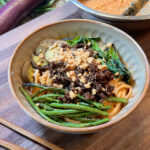Bicol Express is one of the spiciest dishes of the Philippines. Tender pork is stewed in a rich, savory coconut sauce, making it perfect alongside a bowl of rice and fresh vegetables. This is the classic comfort food amongst Filipinos!
I finally got to put out this recipe after so many requests from all of you…And after the final approval from my Bicolano mom. You can give her a big pat on the back for this recipe since she tasted everything from the early trials!
As a forewarning, this recipe is made to be spicy. You can always adjust the chilies according to preference, but to be an authentic Bicol Express, you have to load this with chilies. If that’s not your thing, you can turn away now (just kidding).

What is Bicol Express?
Bicol Express is a spicy and savory pork dish that’s stewed in coconut milk to give it a rich and creamy sauce. The primary ingredient for the dish includes alamang, a salty fermented shrimp paste that lends the dish tons of umami flavor and a slight pinkish-hue.
The authentic version of this dish actually tends to have more chilies, which served to showcase their bold spiciness. The pork, as a result, was not the star of the dish, but were simply an add-ons. Overtime, however, the dish evolved to become a popular pairing with rice, and so the ratios of the proteins were increased.

The name was termed by Cely Kalaw during a 1970s cooking competition in Manila. Inspired by the Bicol Express railway train, the name stuck and the rest was history (thanks Wikipedia!).
After gaining popularity, variants of Bicol Express started popping up in the form of protein substitutes (e.g., beef, chicken, tuna) and even vegetarian options.
Key Ingredient: Alamang
The number one thing my mom stressed when making Bicol Express was to use alamang, a type of pink Filipino shrimp paste. In Bicol, this may also be called balao, which were slightly less fermented and had less of an intense saltiness than what you’d get in alamang jars.
You can purchase alamang in most Filipino grocery stores or in large Asian supermarkets.

Living in the West, grabbing a jar of alamang was the most feasible option since it can be extremely difficult to find the fresh kinds. The only caveat was that jarred alamang was incredibly salty -too salty in fact to be palatable on its own.
To address this, we would briefly rinse the alamang with room temperature water, just enough to wash away some of its salt, but not enough to dilute its umami flavors.

Other recipes would call for you to use bagoong guisado (the brown Filipino shrimp paste) as a substitute if you couldn’t find the pink kind. That’s fine, no biggy. Honestly I’m not a huge purist for recipes since you have to work with what you got.
Many Filipinos would only comment that using the guisado over alamang would stray away from the original authentic recipe. The guisado paste already comes pre-seasoned and has a completely different flavor profile than alamang, which changes the Bicol Express dish entirely.
*If you wanted to learn more about bagoong, I made a page dedicated specifically for that ingredient.
Instructions for Bicol Express
Cut your pork into bite-sized pieces and season with black pepper. Sear the pork in a pan over medium-high heat to develop some color and to render out some of its fat. Once the pork is seared and browned all over, set aside.

In the same pan, saute the onions until soft, about 3 minutes. Add in the garlic, ginger, and Thai chilies, and continue to saute until fragrant, about 2 more minutes.

Add in the seared pork, alamang, coconut milk, water, and sugar. Stir to combine.
Bring to a boil, then lower the heat to a medium-low and let simmer with a lid on for 45 minutes.

After 45 minutes, mix in the green chilies. You’ll know the Bicol Express is done when the oils from the coconut milk and pork begin to separate slightly. Serve with rice and veggies. Enjoy!


FAQs
What cut of pork should I use?
Fatty cuts of pork like shoulder or belly are perfect for this recipe.
If you wanted a lighter dish, feel free to use leaner cuts such as the loin.
What do I serve this with?
Like with most Filipino food, Bicol Express goes perfectly with a bowl of warm rice to be drenched in that luxurious sauce.
Popular veggies that pair with this dish include bok choy or eggplant, which help to cut through the richness and spiciness of the dish.
Looking for more tasty recipes? Here’s a couple you might love:
Disclosure: Some links on this page are affiliate links, meaning that at no additional cost to you, we may receive compensation from purchases made through these links. As an Amazon Associate, I can earn from qualifying purchases.








5 star rating from a real Bicolana! This is the first time I have seen the term balao used in a Bicol Express recipe, and it made me smile!
Hi Chrissy, glad you enjoyed this recipe 🙂 I appreciate it!